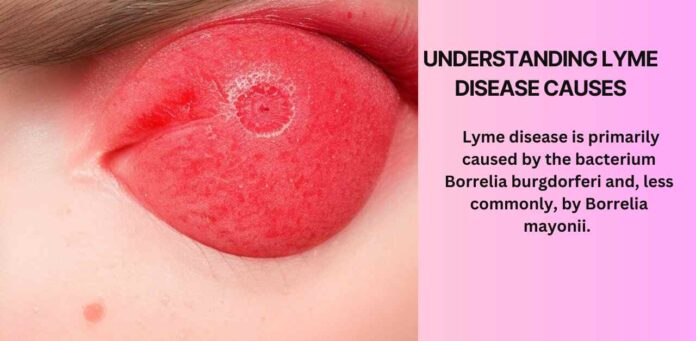Understanding Lyme Disease Causes, Symptoms, Diagnosis, and Treatment
Understanding Lyme Disease Causes, Symptoms, Diagnosis, and Treatment , a tick-borne illness, has emerged as a significant public health concern worldwide. Named after the town of Lyme, Connecticut, where it was first identified in the 1970s, this complex infection can affect multiple systems in the body. In this article, we will explore the causes, symptoms, diagnosis, and treatment of Lyme disease, shedding light on the importance of early detection and comprehensive management.
Causes and Transmission
Understanding Lyme Disease Causes, Symptoms, Diagnosis, and Treatment of Lyme disease is primarily caused by the bacterium Borrelia burgdorferi and, less commonly, by Borrelia mayonii. These bacteria are transmitted to humans through the bites of infected black-legged ticks (Ixodes scapularis in the northeastern United States and Ixodes pacificus in the western United States). Ticks become infected by feeding on small mammals, such as mice and deer, which serve as reservoir hosts for the bacteria.
Here are the later signs and symptoms of Lyme disease that often affect your joints and nervous system
- You might get really bad headaches, and your neck might feel stiff.
- Sometimes you might notice rashes on other parts of your body.
- Your face might start to droop on one or both sides, which is called facial palsy.
- Your knees might swell up and hurt a lot, especially when you try to move them.
- You could feel pain that comes and goes in your muscles, joints, bones, and tendons.
- Your heartbeat might start to act funny, which is called arrhythmia.
- You might have times when you feel dizzy or find it hard to breathe.
- You might experience shooting pains, numbness, or tingling sensations in your hands or feet.
- Early Localized Stage: The first sign is often a circular rash, called erythema migrans (EM), at the site of the tick bite. It may resemble a “bull’s-eye” pattern.Flu-like symptoms may accompany the rash, including fever, chills, headaches, fatigue, and muscle and joint aches.
- Early Disseminated Stage: If left untreated, the bacteria can spread throughout the body, causing more severe symptoms. Neurological symptoms may include facial paralysis, meningitis, and impaired muscle movement. Cardiac involvement can lead to heart palpitations and inflammation of the heart muscles.
- Late Disseminated Stage: Months or even years after the initial infection, some individuals may experience persistent symptoms. Arthritis, particularly in large joints like the knees, is a common manifestation of late-stage Lyme disease.
Diagnosis and Testing of Lyme disease
Diagnosing Lyme disease can be challenging due to its diverse clinical presentation and the possibility of overlapping symptoms with other illnesses. Doctors often rely on a combination of medical history, physical examination, and specific laboratory tests to confirm the diagnosis.The presence of an EM rash is a strong indicator of early-stage Lyme disease, and no further testing may be necessary in such cases.
Lyme disease tests are procedures
Understanding Lyme disease blood test results
Antibodies to the Lyme bacteria are found in blood tests, such as Western blot assays and enzyme immunoassays (EIA). However, these tests might produce false negatives in the early stages.
Treatment and Prevention of Lyme disease
Early detection and prompt treatment are crucial to preventing Lyme disease from progressing to its more severe stages. Antibiotics, such as doxycycline, amoxicillin, or cefuroxime, are commonly prescribed for 10–21 days during the early stages. In cases of neurologic or cardiac involvement, intravenous antibiotics may be necessary.
To prevent Lyme disease, avoid tick-infested areas, especially during peak tick seasons (spring and summer). Wear long-sleeved clothing and use tick repellents when in wooded or grassy areas. Conduct regular tick checks on yourself, family members, and pets after outdoor activities.
Conclusion
Lyme disease is a complex and potentially debilitating illness that demands attention from both the medical community and the public. By staying informed about its causes, symptoms, diagnosis, and treatment, we can collectively work towards minimizing its impact on individuals and communities. Remember, prevention and early intervention are the keys to managing Lyme disease effectively and preserving the overall well-being of those at risk.
Frequently Asked Questions (FAQ) about Lyme Disease
What is Lyme disease?
Lyme disease is a tick-borne infection caused by the bacterium Borrelia burgdorferi and, less commonly, Borrelia mayonii. It is primarily transmitted to humans through the bites of infected black-legged ticks (Ixodes scapularis and Ixodes pacificus).
What are the symptoms of Lyme disease?
The symptoms of Lyme disease can vary depending on the stage of infection. In the early localized stage, a circular rash known as erythema migrans may appear, along with flu-like symptoms such as fever, chills, headache, fatigue, and muscle aches. As the disease progresses to the early disseminated stage, neurological and cardiac symptoms may develop. It is possible for big joint arthritis to develop in the late-disseminated stage.
How is Lyme disease diagnosed?
Diagnosing Lyme disease can be challenging due to its diverse symptoms. Doctors typically rely on a combination of medical history, physical examination, and laboratory tests. The presence of an erythema migrans rash is a strong indicator of early-stage Lyme disease.
Can Lyme disease be treated?
Yes, Lyme disease can be treated with antibiotics. Early detection and prompt treatment are essential to prevent the disease from progressing to its more severe stages. Commonly prescribed antibiotics include doxycycline, amoxicillin, and cefuroxime, usually taken for 10–21 days during the early stages. In severe cases, such as those involving neurological or cardiac complications, intravenous antibiotics may be necessary.
How can I prevent Lyme disease?
To prevent Lyme disease, avoid tick-infested areas, especially during peak tick seasons (spring and summer). Wear long-sleeved clothing and use tick repellents when in wooded or grassy areas. Conduct regular tick checks on yourself, family members, and pets after outdoor activities.
Generally, in which place is Lyme disease commonly found?
Lyme disease is prevalent in wooded and grassy areas of the United States, Europe, and Asia. In the U.S., it is particularly common in the northeastern and north-central regions, as well as certain parts of the West Coast.
What should I do if I find a tick on myself or my pet?
If you find a tick attached to your skin or your pet’s fur, remove it carefully using fine-tipped tweezers. Grasp the tick close to the skin’s surface and pull upward with steady, even pressure. Use soap, water, and rubbing alcohol to clean the bite area. Monitor yourself or your pet for any signs of illness and consult a healthcare professional or veterinarian if necessary. Understanding Lyme Disease Causes, Symptoms, Diagnosis, and Treatment Remember, early detection and prevention are vital in managing Lyme disease effectively. Stay informed about the risks, take appropriate precautions, and seek medical attention if you suspect you or someone you know may have contracted Lyme disease.





